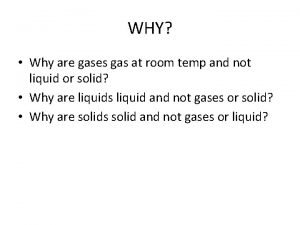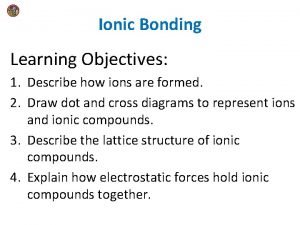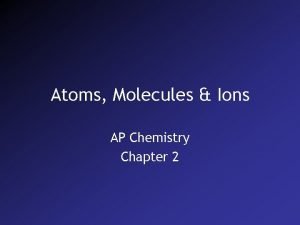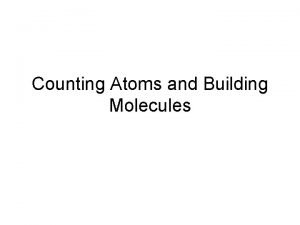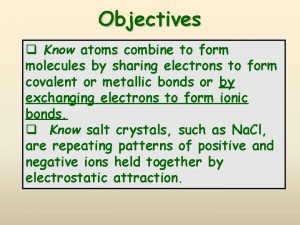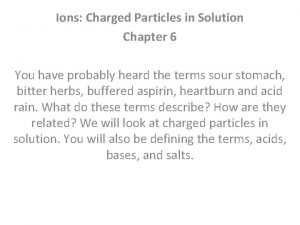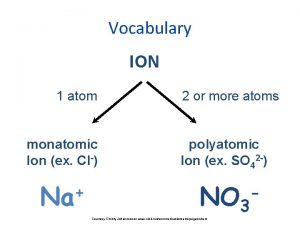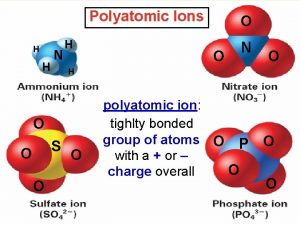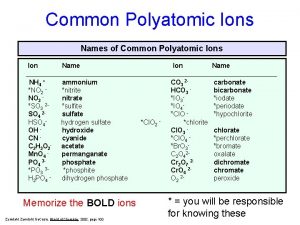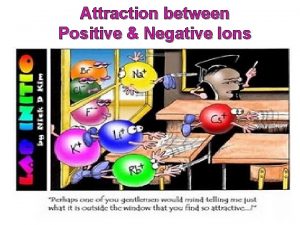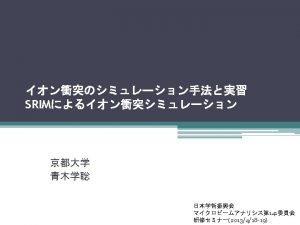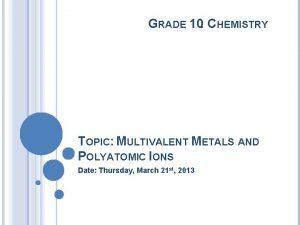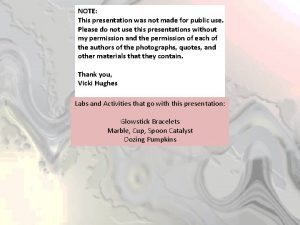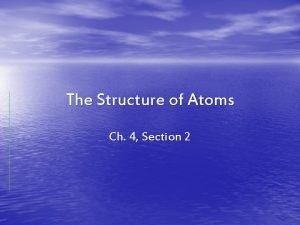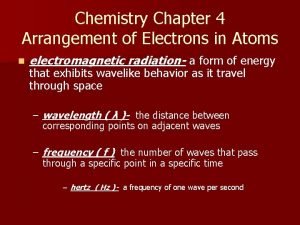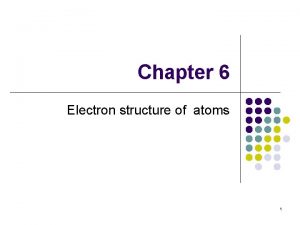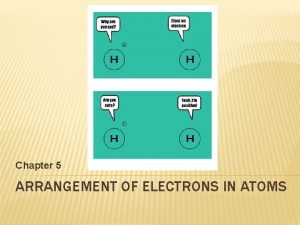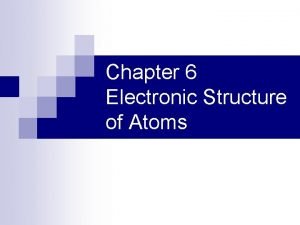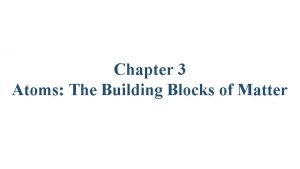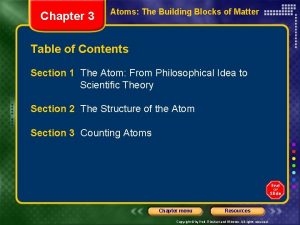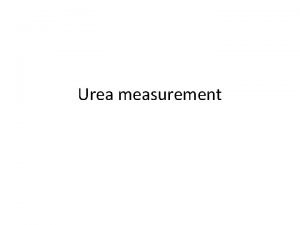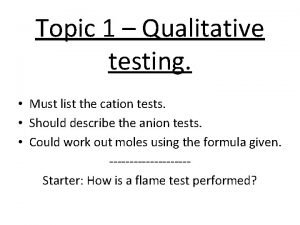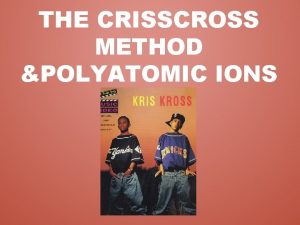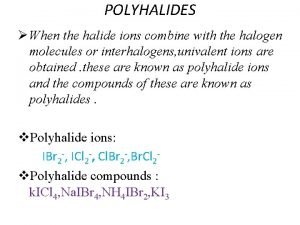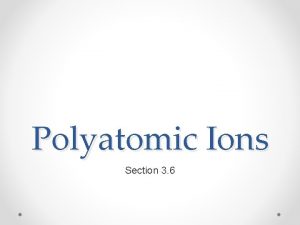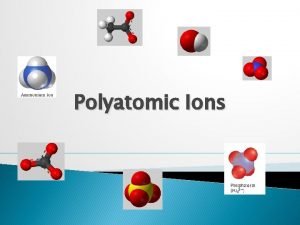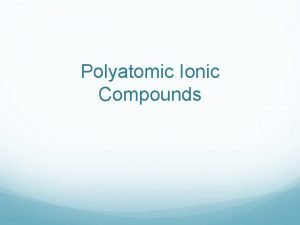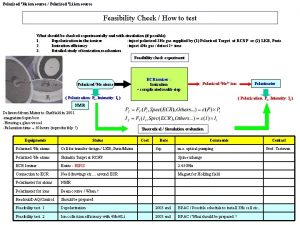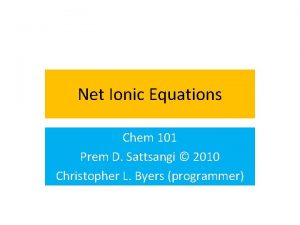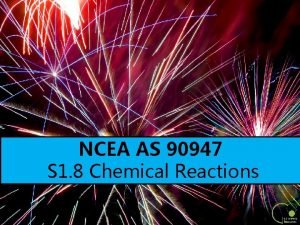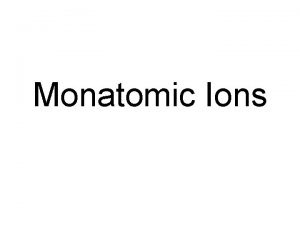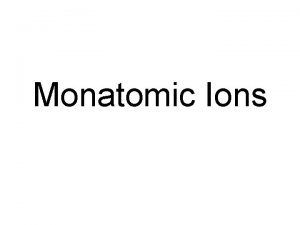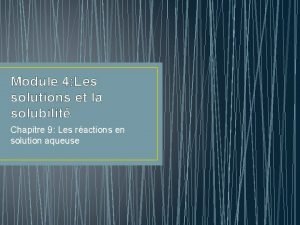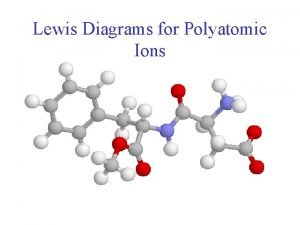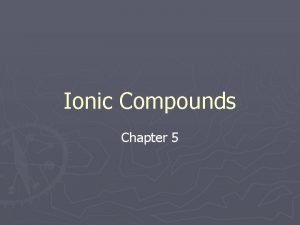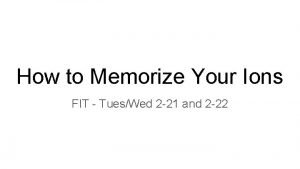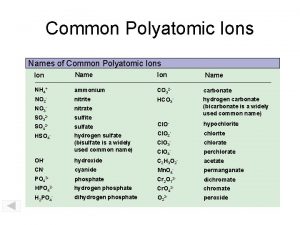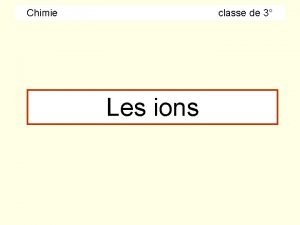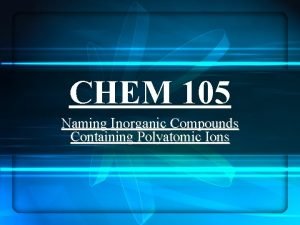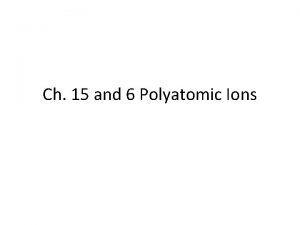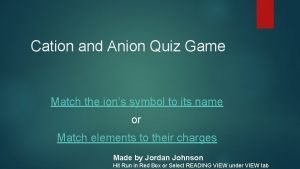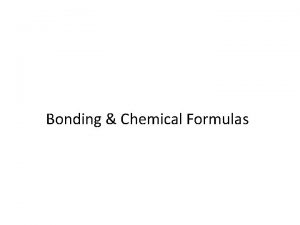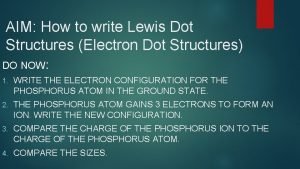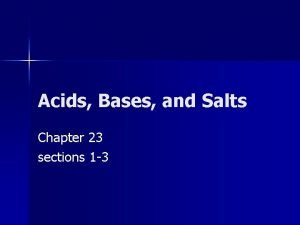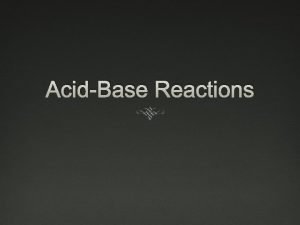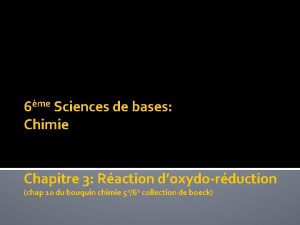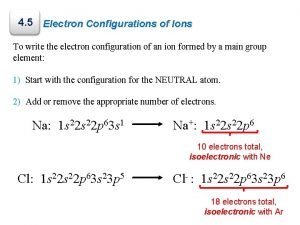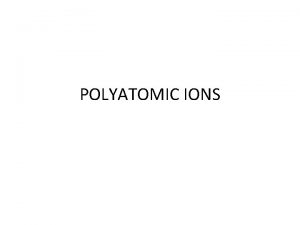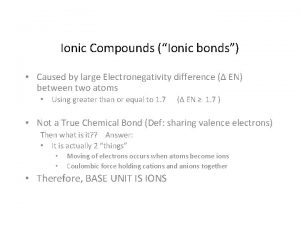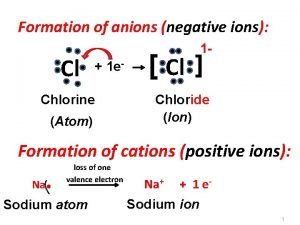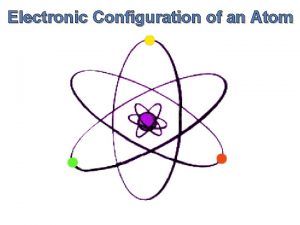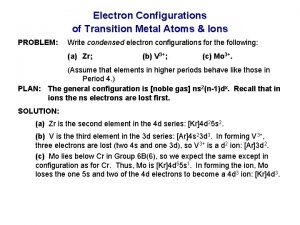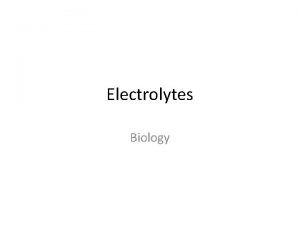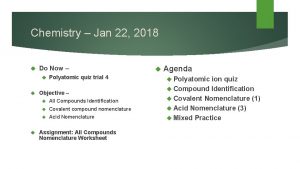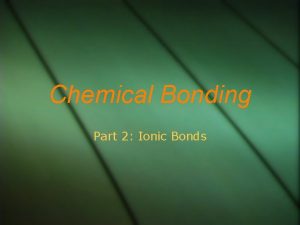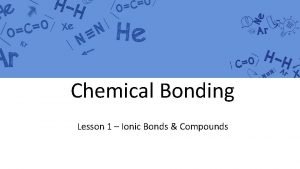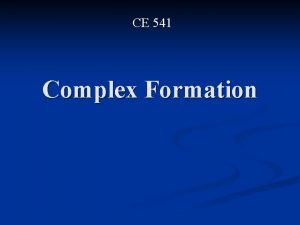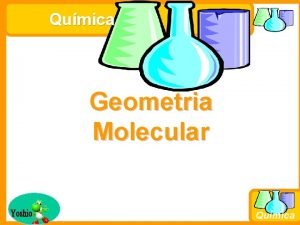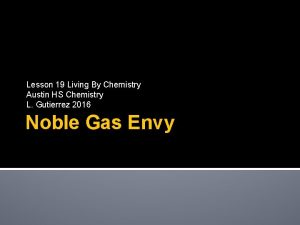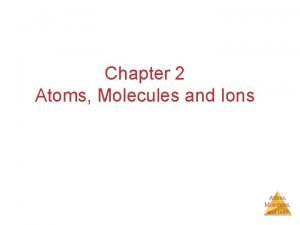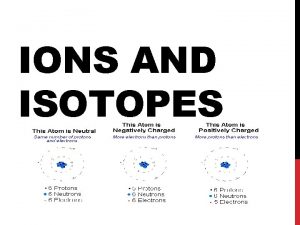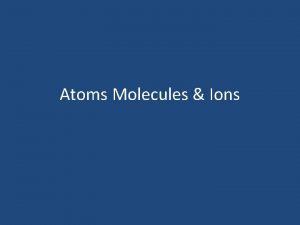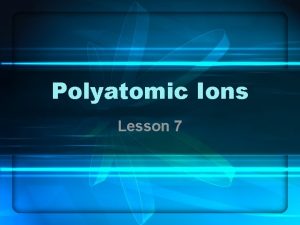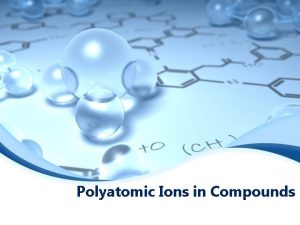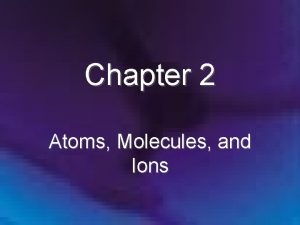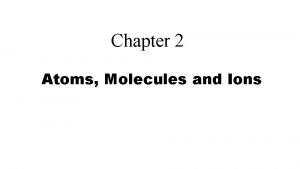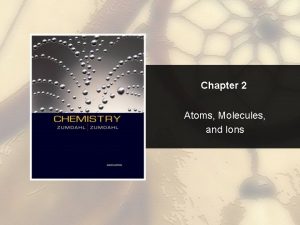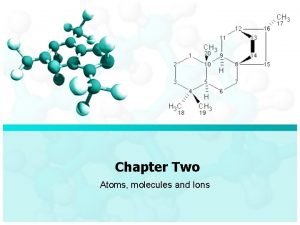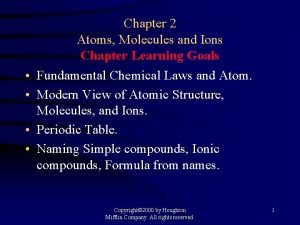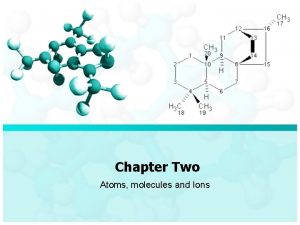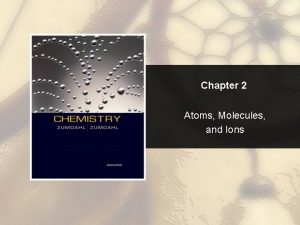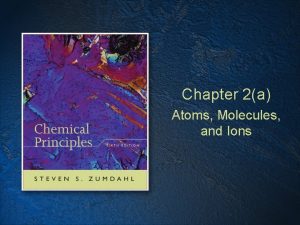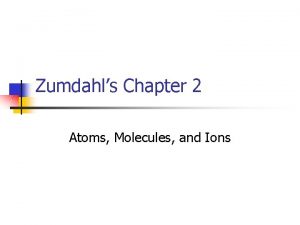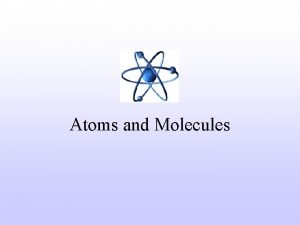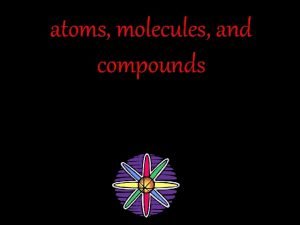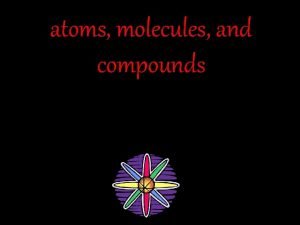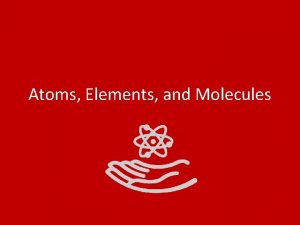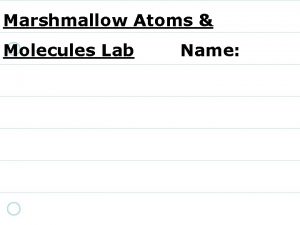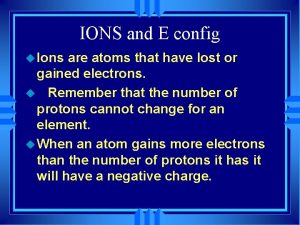Chapter 4 Atoms Molecules and Ions Atoms Molecules



























































































- Slides: 91

Chapter 4 Atoms, Molecules, and Ions

Atoms, Molecules, and Ions • The vocabulary of chemistry is specialized. • It includes such terms as atom, ion, molecule, isotope, acid, base, salt, and saturated hydrocarbon. • Chemistry also involves symbolic notation. • Atoms of elements are represented by symbols, such as H, C, N, O, Na, and Cl. These symbols are the alphabet of chemistry. • To represent compounds, symbols are combined into chemical formulas, such as Na. Cl, and formulas are the words of chemistry.

Molecule models S 8 12. 10. 2009 C 4 3

Molecular compounds 12. 10. 2009 4

Some molecules H 2 O 2 CH 3 -CH(OH)-CH 3 12. 10. 2009 CH 3 CH 2 Cl P 4 O 10 HCOOH 5

Molecule models 12. 10. 2009 6

4. 1 Laws of Chemical Combination • Data obtained by experiment can often be summarized into laws. Scientific theories are then formulated to explain these laws. New laws are formulated making use of other laws. BRICKS ON THE WALL!!!! Lavoisier: The Law of Conservation of Mass • Modern chemistry dates from the eighteenth century, when scientists began to make quantitative observations. • Antoine Lavoisier made mass measurements precise to about 0. 0001 g and established that total mass does not change during a chemical reaction. 12. 10. 2009 Gen. Chem. Chapter 2 7

• For example, Lavoisier heated the red oxide of mercury, causing it to decompose (break down) to two new products: mercury metal and oxygen gas. • By measuring carefully, he found that the total mass of the products was exactly the same as the mass of the mercury oxide he started with. • Lavoisier summarized his findings through the law of conservation of mass. The total mass remains constant during a chemical reaction. 12. 10. 2009 8

• Is the mass of the burned match pictured in the photograph the same as, less than, or more than the mass of the burning match? The match loses mass in the reaction. This kind of loss of mass to carbon dioxide during burning greatly confused early chemists who did not measure the mass of the gases produced. The rule of conservation of matter is credited to Lavoisier. 12. 10. 2009 9

Proust: The Law of Definite Proportions • By the end of the eighteenth century, Lavoisier and other scientists had succeeded in decomposing many compounds into the elements that form them. • One of these scientists, Joseph Proust (1754– 1826), did careful quantitative studies by which he established the • law of constant composition • (also called the law of definite proportions). All samples of a compound have the same composition; that is, all samples have the same proportions, by mass, of the elements present in the compound. 12. 10. 2009 10

The Mineral Malachite • Chemistry: Cu 2(CO 3)(OH)2, Copper Carbonate Hydroxide. • Class: Carbonate 12. 10. 2009 11

The law of definite proportions A substance known as basic copper carbonate (a) occurs in nature as the mineral malachite, (b) forms as a patina on copper roofs and bronze statues, and (c) can be synthesized in the laboratory. Regardless of its source, basic copper carbonate always has the same composition. 12. 10. 2009 12

• Proust based this law in part on his studies of a substance that we now call basic copper carbonate ; all samples of this compound have the same composition: • 57. 48% copper, • 0. 91% hydrogen, • A compound not only has a constant, or fixed, composition; it also has 5. 43% carbon, and 36. 18% oxygen by mass. fixed properties. • For example, under normal atmospheric pressure, pure water always freezes at 0 °C and boils at 100 °C. 12. 10. 2009 Gen. Chem. Chapter 2 13

• The physical and chemical properties of chemical substances—both elements and compounds—depend on their composition. • A twentieth-century modification of this law, based on the work of Albert Einstein, allows for the possibility of converting mass to energy (and vice versa). • This need not concern us, however, because in chemical rections the amounts of mass converted to energy are too small to detect. 12. 10. 2009 14

4. 2 John Dalton and the Atomic Theory of Matter In 1803, John Dalton proposed a theory to explain the laws of conservation of mass and constant composition. As he developed what would become known as his atomic theory, Dalton found evidence of a scientific law describing the composition of matter. In some cases, atoms of the same two elements are able to combine to form two or more different compounds, and the compositions of the different compounds are related. 12. 10. 2009 15

• Let's illustrate Dalton's reasoning with a simple example: two compounds composed of the elements carbon and oxygen. • In carbon dioxide (the familiar gas produced in respiration and in the burning of fuels) the two elements combine in the ratio of 8. 0 g of oxygen to 3. 0 g of carbon. • In carbon monoxide (the poisonous gas formed when a fuel is burned in limited air) the elements combine in the ratio of 4. 0 g of oxygen to 3. 0 g of carbon. • Based on evidence such as this, Dalton formulated • the law of multiple proportions, • which we can state in the following way: In two or more compounds of the same two elements, the masses of one element that combine with a fixed mass of the second element are in the ratio of small whole numbers. 12. 10. 2009 16

Law of Multiple Proportions 12. 10. 2009 Ratio of oxygen-to-carbon in CO 2 is Gen. Chem. twice Chapter 2 exactly the ratio in CO. 17

Law of Multiple Proportions • Four different oxides of nitrogen can be formed, by combining 28 g of nitrogen with: • 16 g oxygen, forming Compound I • 48 g oxygen, forming Compound II • 64 g oxygen, forming Compound III • 80 g oxygen, forming Compound IV What is the ratio 16: 48: 64: 80 expressed as small whole numbers? • Compounds I–IV are N 2 O, N 2 O 3, N 2 O 4, N 2 O 5 12. 10. 2009 18

• Dalton's Atomic Theory • The atomic model Dalton developed to explain the laws of chemical combination is based on four ideas: • All matter is composed of extremely small, indivisible particles called atoms. • All atoms of a given element are alike in mass and other properties, but the atoms of one element differ from the atoms of every other element. • Compounds are formed when atoms of different elements unite in fixed proportions. That is, one atom of A to one of B in AB, two atoms of A to one of B in A 2 B and so on. • A chemical reaction involves a rearrangement of atoms to produce new compounds. No atoms are created, destroyed, or broken apart in a chemical reaction. 12. 10. 2009 19

Atomic Theory Illustrated … The law of conservation of mass is also illustrated in Figure. The figure shows that six fluorine atoms (in the form of three molecules) and four hydrogen atoms (as two molecules) are available for reaction. Four of the F atoms combine with the four H atoms, producing four HF molecules. Two fluorine atoms do not react and are left unchanged as one molecule. Thus, after the reaction there are four hydrogen atoms and six fluorine atoms, just as there were before. The total mass EOS remains unchanged. With Dalton's atomic theory, we can restate the law of conservation of mass in this way: Atoms can neither be created nor destroyed in a chemical reaction; thus, the total mass remains unchanged. 12. 10. 2009 20

Dalton’s Symbols 12. 10. 2009 Gen. Chem. Chapter 2 21

4. 3 The Divisible Atom • However, like most other scientific theories, Dalton's model eventually had to be modified in light of later discoveries. • Toward the end of the nineteenth century, certain experiments began to reveal that atoms are made up of smaller parts. • Of the dozens of subatomic (smaller than atomic) particles now known, three are of special importance in the study of chemistry. • They are the proton, neutron, and electron. 12. 10. 2009 22

Subatomic Particles • The mass and charge of subatomic particles are so small that they are conveniently expressed in relative units. • The proton has a relative mass of 1. The proton also carries one fundamental unit of positive electric charge, denoted 1+. • The neutron, as its name implies, is an electrically neutral particle; it has no charge. Although its mass is slightly greater than that of the proton, for many purposes we can consider the neutron also to have a relative mass of 1. • The third particle, the electron, has a mass that is 1/1836 (or 0. 0005447) of the mass of a proton. An electron has the same quantity of charge as a proton, but it is a negative charge, denoted as 1 -. • Protons, neutrons, and electrons are fundamental particles. This means that all protons are alike, all neutrons are alike, and all electrons are alike in whatever element they are found. 12. 10. 2009 23

Nuclear Structure Atomic Diameter 10 -8 cm Nuclear diameter 10 -13 cm =1Å 12. 10. 2009 24

Subatomic Particles • Protons and neutrons are densely packed into a tiny, positively charged core of the atom known as the nucleus. • The extremely lightweight electrons are widely dispersed around the nucleus. • An atom as a whole is electrically neutral: It has no net charge because the negative and positive charges balance each other. • Although the numbers differ from one element to another, the atoms of every element have equal numbers of electrons and protons. 12. 10. 2009 25

• Dalton believed that the identity of an element is determined by the mass of one of its atoms. • We now know that it is not the mass of an atom but rather the number of protons in the nucleus that determines the kind of atom and therefore the identity of an element. • The atomic number (Z) is the number of protons in the nucleus of an atom of a given element, and it is this number of protons that defines the element. • Every atom having two protons in its nucleus has Z = 2 and is an atom of helium. • Every atom with 92 protons has Z = 92 and is an atom of uranium. 12. 10. 2009 26

Isotopes • Atoms that have the same number of protons but different numbers of neutrons are called isotopes. • The atomic number (Z) is the number of protons in the nucleus of a given atom of a given element. • The mass number (A) is an integral number that is the sum of the numbers of protons and neutrons in an atom. • The number of neutrons = A – Z. 12. 10. 2009 27

Isotopes • For example, there are three isotopes of hydrogen. • The most abundant isotope, occasionally called protium, has a single proton and no neutrons in its nucleus. • About one in every 6700 hydrogen atoms, however, has a neutron as well as a proton. Because the mass of a neutron is essentially the same as the mass of a proton, the mass of this hydrogen isotope, called deuterium, is about twice that of protium. • A third, very rare isotope of hydrogen, called tritium, has two neutrons and one proton in the nucleus. A tritium atom has about three times the mass of a protium atom. 12. 10. 2009 28

Isotopes of Hydrogen Atomic number (Z) = number of protons Protium has 1 proton, 0 neutrons : Z=1 Deuterium has 1 proton, 1 neutron : Z=1 Tritium has 1 proton, 2 neutrons : Z=1 12. 10. 2009 29

• Some elements have only one naturally occurring isotope; these include fluorine-19, sodium-23, and phosphorus-31. • Most elements, however, have two or more isotopic forms. • Tin has the greatest number of naturally occurring isotopes: 10. • The naturally occurring isotopes are always found in certain precise proportions. In natural sources of chlorine, for example, 75. 77% of the atoms are chlorine-35 and 24. 23% are chlorine-37. • Chemical symbols for isotopes are commonly written in the form with A being the mass number and Z the atomic number of the A element E. ZE • For the two naturally occurring isotopes of chlorine, we can write 35 Cl 17 and 37 Cl 17 indicating mass numbers of 35 and 37 for chlorine-35 and chlorine-37, respectively. 12. 10. 2009 30

Chemical Symbol ÜTo represent a particular atom we use the symbolism: A= mass number Z = atomic number To represent an ion 12. 10. 2009 31

Isotopes Atoms can be represented using the element’s symbol and the mass number (A) and atomic number (Z): A E Z 35 Cl 17 37 Cl 17 • How many protons are in chlorine-35? • How many protons are in chlorine-37? • How many neutrons are in chlorine-37? 12. 10. 2009 32

Other Examples of Isotopes The number of neutrons = A – Z Carbon-12 Carbon-13 Carbon-14 Z=6 Z=6 so 6 neutrons so 7 neutrons so 8 neutrons Chlorine-35 Chlorine-37 Z = 17 so 18 neutrons so 20 neutrons Uranium-234 Uranium-235 Uranium-238 Z = 92 so 142 neutrons so 143 neutrons so 146 neutrons 12. 10. 2009 33

4. 4 Atomic Masses • We are familiar with measuring the mass of a macroscopic sample of matter. (Ex: a bag of apples or a letter on a postal scale. • But how can we weigh an individual atom, a microscopic sample of matter that we can't even see? • We can do what John Dalton did: arbitrarily assign a mass to one atom and determine the masses of other atoms relative to it. • Dalton called these relative masses atomic weights, and let's do the same for the time being. Suppose we assign a mass of 1 to the hydrogen atom, just as Dalton did. Now, to establish the mass of an oxygen atom, we can measure the mass ratio of hydrogen to oxygen in water. • The best value available in Dalton's time was 1 g H : 7 g O (The modern value is 1 g H : 8 g O ) 12. 10. 2009 34

12. 10. 2009 35

• At this point, Dalton assumed that H and O atoms in water were combined in the numerical ratio 1 : 1. • Then, if a given number of oxygen atoms weighed seven times as much as the same number of hydrogen atoms, one oxygen atom must also weigh seven times as much as a hydrogen atom. Thus, Dalton assigned oxygen an atomic weight of 7. • However, if we apply our current understanding that the mass ratio of H to O in water is 1 : 8 and that there are two H atoms for every O atom in water, we get a value of 16 for the atomic weight of oxygen. • Once chemists figured out how to determine the combining ratios of atoms in compounds, they were able to measure atomic weights rather easily. 12. 10. 2009 36

• By international agreement, the current atomic mass standard is the pure isotope carbon-12, which is assigned a mass of exactly 12 atomic mass units (12 u). • Based on this standard, we can define an atomic mass unit (abbreviated amu and having the unit u) as exactly one-twelfth the mass of a carbon-12 atom. • In more familiar units of mass, 1 u = 1. 66054 x 10 -24 g. • Because we are interested in the masses of atoms and not their weights, we will now shift to the term atomic mass in place of the older atomic weight, except in a few cases of historical interest. 12. 10. 2009 37

• The atomic mass of an element is defined as the weighted average of the masses of the naturally occurring isotopes of that element. • Consider carbon, which consists of a mixture of two naturally occurring isotopes. • The much more abundant isotope is carbon-12. The other is carbon-13, with a mass of 13. 00335 u. Both isotopes are present in substances containing carbon atoms, and in proportions that generally do not vary from one carbon-containing substance to another. ( C Dating ) • To describe the atomic mass of carbon, then, we need to use an average value, but not the simple average (12 + 13) / 2 = 12. 5. Because carbon-12 is much more abundant than carbon-13, the average we seek lies much closer to the mass of carbon-12 than to that of carbon-13. We say that it is "weighted" toward the mass of carbon-12. 10. 2009 38

• To calculate the atomic mass of an element, we need two quantities— • (1) the atomic masses of the isotopes of the element and • (2) the naturally occurring fractional abundances of the isotopes. • Let us explain how these quantities are obtained experimentally • To illustrate, let's return to the atomic mass of carbon. 12. 10. 2009 39

• The percentage abundances and fractional abundances of the carbon isotopes are as follows: To obtain a weighted average atomic mass, we calculate the contribution of each isotope to the weighted average from the relationship The term atomic weight is still widely used, however, as by the Commission on Atomic Weights of the International Union of Pure and Applied Chemistry (IUPAC). 12. 10. 2009 40

Use the data cited below to determine the weighted average atomic mass of carbon. The contribution of each isotope to the weighted average atomic mass is given by Equation. Solution The contributions are Contribution of carbon-12 = 0. 98892 x 12. 00000 u = 11. 867 u Contribution of carbon-13 = 0. 01108 x 13. 00335 u = 0. 1441 u The weighted average atomic mass is the sum of the two contributions. Atomic mass of carbon = 11. 867 u + 0. 1441 u = 12. 011 u 12. 10. 2009 41

2. 5 The Periodic Table: Elements Organized • In the nineteenth century, chemists discovered dozens of new elements. • By 1830, 55 elements were recognized, but there was no apparent pattern in their properties. Chemists badly needed a way to organize the growing collection of chemical data. • One way to do this was to arrange the elements in a manner that would establish categories of elements having similar physical and chemical properties. • Dimitri Mendeleev published the first successful arrangement, called a periodic table, in 1869. • In its modern form, the periodic table organizes a vast array of chemical knowledge. 12. 10. 2009 42

Mendeleev's Periodic Table Mendeleev arranged the elements in order of increasing atomic weight, from left to right in rows and from top to bottom in columns (or groups). In this arrangement, elements that most closely resemble one another in physical and chemical properties tend to fall in the same vertical group. This group similarity recurs periodically, hence the name periodic table. • There would be no exceptions to the principle that all the elements in a group display similar properties, • Mendeleev placed some elements out of order, that is, not in the strict order of increasing atomic weight. 12. 10. 2009 43

For example, he correctly placed tellurium (atomic weight 127. 6) ahead of iodine (atomic weight 126. 9) so that tellurium would be in the same column as the similar elements sulfur and selenium. 12. 10. 2009 44

• When Mendeleev placed elements with similar properties in the same vertical group, a few gaps were created in his table. • Instead of seeing these gaps as defects, he boldly predicted the existence of undiscovered elements to fill the gaps. • Furthermore, because the table was based on patterns of properties, he was able to predict some properties of the missing elements. 12. 10. 2009 45

Mendeleev’s Table Dimitri Mendeleev created this, the original periodic table. Stowe's table Spiral form Triangular form Folded Table Periodic Table 12. 10. 2009 Mendeleevs’s early table was published in 1872. • Using his table he was able to correct several values of atomic masses. • Because of its obvious usefullness his periodic table was almost universally adopted, and it remains one of the most valuable tools at the chemist’s use. • The only fundemantal difference between todays table and that of his is that in the current table the elements are ordered by atomic number rather than by atomic mass. 46

• For example, he left a blank space for an undiscovered element that he called "eka-silicon" and used its location between silicon and tin to predict an atomic weight of 72 and other properties. • Table 2. 2 shows just how accurate his predictions were, when compared to the properties of the actual element germanium discovered 15 years later. • The predictive nature of Mendeleev's periodic table led to its wide acceptance as a tremendous scientific accomplishment. 12. 10. 2009 Gen. Chem. Chapter 2 47

Alkali Metals The Periodic table Alkaline Earths Halogens Noble Gases Main Group Transition Metals Main Group 12. 10. 2009 Lanthanides and Actinides 48

• • • The Modern Periodic Table There are more than 110 elements listed in the modern periodic table. Each box, or entry, in the table gives the chemical symbol, atomic number (Z), and atomic mass of an element (illustrated for iron). The elements are placed in order of increasing atomic number, a property more responsible for the behavior of an element than is its atomic mass. 12. 10. 2009 49

Empirical and Molecular Formulas Empirical formula: the simplest whole number ratio of elements in a compound Example: Molecular formula of glucose – C 6 H 12 O 6 The elemental ratio C: H: O is 1: 2: 1, so the empirical formula is CH 2 O 12. 10. 2009 50

Molecular compounds 12. 10. 2009 51

Introduction to Compounds A molecule is a group of two or more atoms held together by covalent bonds. A chemical formula is a symbolic representation of the composition of a compound in terms of its constituent elements. 12. 10. 2009 52

Formulas 12. 10. 2009 53

Binary Molecular Compounds Molecular formulas are usually written with the more “metallic” first – “metallic” means farther left in the period and lower in the group Compounds that are typically comprised of two nonmetallic elements: e. g. , CO, NO, HF 12. 10. 2009 54

Formulas and Subscripts are used when a given atom is used more than once e. g. , H 2 O, CO 2, N 2 O, HF, B 2 O 3 The presence of subscripts is reflected in the names of compounds 12. 10. 2009 55

Names of Binary Compounds Consider the compounds CO and CO 2 The compound name consists of two words, one for each element in the compound Name the element that appears first in the formula: CARBON The second element has an altered name: retain the stem of the element name and replace the ending by -ide OXYGEN OXIDE However, both compounds cannot be carbon oxide 12. 10. 2009 56

Names of Binary Compounds Consider the compounds CO and CO 2 The names are further modified by adding prefixes to denote the numbers of atoms 12. 10. 2009 57

4. 7 Ions and Ionic Compounds In an isolated atom, the number of protons equals the number of electrons, and the atom is therefore electrically neutral. In some chemical reactions, however, an individual atom or a group of bonded atoms may lose or gain one or more electrons, thereby acquiring a net electric charge and becoming an ion. Ions are formed only through the loss or gain of electrons; there is no change in the number of protons in the nucleus of the atom(s). If electrons are lost, there are more protons than electrons in the resulting ion and so it has a positive charge. If electrons are gained, there are more electrons than protons in the resulting ion and so it has a negative charge. 12. 10. 2009 58

Ions and Ionic Compounds Atoms that gain or lose electrons are called ions Positive ions: CATIONS Atoms that lose electrons form cations Na Na+ + e– 12. 10. 2009 Negative ions: ANIONS Atoms that gain electrons form anions Cl + e– Cl– 59

Monatomic Ions Group A metals usually lose the number of electrons equal to their Group number. Nonmetal atoms usually gain electrons and have a charge equal to their Group number minus eight. The periodic table cannot be used to determine the charge on Group B metals. For naming, Group B metals capable of multiple charges have the corresponding Roman numeral in parentheses added after the element name. 12. 10. 2009 60

Common Monatomic Ions FIGURE 4. 10 Symbols and periodic table locations of some monatomic ions Three general observations can be made of these data: (1) Aluminum and the metals of groups 1 A and 2 A form just one cation, which carries a positive charge equal in magnitude to the A-group number. (2) Most of the metals of the B groups form two or more cations of different charges, though in some cases only one of these cations is commonly encountered. (3) The nonmetals of groups 7 A and 6 A, along with nitrogen and phosphorus of group 5 A, form anions that have a charge equal to the group number minus 8. 12. 10. 2009 Gen. Chem. Chapter 2 61

Formulas and Names for Ionic Compounds Ionic compounds form when oppositely charged ions are attracted to each other Na. Cl Resulting compound is electrically neutral Na+ Cl– (+1) + (– 1) = 0 Ionic compound names use the cation name followed by the anion name 12. 10. 2009 Sodium chloride 62

Now consider the formula for aluminum oxide. We cannot simply combine one Al 3+ and one O 2 - , because this would produce a formula unit with a net charge of 1+. The combination of two Al 3+ ions and three O 2 - ions, though, is an electrically neutral formula unit: 2 (3+) + 3 (2 -) = + 6 - 6 = 0 Therefore, the formula for aluminum oxide is 12. 10. 2009 Al 2 O 3. 63

Polyatomic Ions Polyatomic ions are charged groups of covalently bonded atoms 12. 10. 2009 Gen. Chem. Chapter 2 64

Hydrates A hydrate is an ionic compound in which the formula unit includes a fixed number of water molecules associated with cations and anions Examples: Ba. Cl 2. 2 H 2 O Cu. SO 4. 5 H 2 O 12. 10. 2009 65

Acids • Taste sour • Turn blue litmus paper red • React with metals to form hydrogen gas • Neutralize a base Intro. To. Acids 12. 10. 2009 66

Bases • Taste bitter • Turn red litmus paper blue • Feel slippery on skin • Neutralize an acid Intro. To. Bases 12. 10. 2009 Gen. Chem. Chapter 2 67

Arrhenius Concepts Acids are compounds that ionize in water to form a solution of H+ ions and anions Bases are compounds that ionize in – water to form solutions of OH and cations Acids and bases react to form a salt and water = neutralization 12. 10. 2009 68

Arrhenius Concepts Acids and bases react to form a salt and water = neutralization HCl + Na. OH “Salt” + Water Acid Base Na. Cl HOH cation/anion 12. 10. 2009 69

Formulas and Names for Acids Binary acids start with hydro and end with “ic” plus the word acid Ternary acids simply use the polyatomic anion name with “ate” changing to “ic” plus the word acid 12. 10. 2009 70

Formulas and Names for Bases Arrhenius bases always have hydroxide ions The name follows ionic compound convention e. g. , Na. OH – sodium hydroxide Molecular bases form OH– after reacting with water NH 3 + HOH NH 4 OH Ammonia ammonium hydroxide 12. 10. 2009 71

Formulas and Names for Salts Binary salts use the “ide” ending on the anion name e. g. , sodium chloride Polyatomic salts use “ate” ending on the anion name e. g. , sodium sulfate 12. 10. 2009 72

12. 10. 2009 73

Organic Compounds • Organic Chemistry is the study of carbon and its compounds • Carbon compounds containing one or more of the elements H, O, N, or S are especially common • Most organic compounds are molecular compounds • Can exist as acids, bases, and salts • Compounds have systematic names AND common names 12. 10. 2009 74

Representations of Molecules Condensed Structural Formula CH 3 CH 2 CH 3 Structural Formula Ball and Stick 12. 10. 2009 75

Saturated Hydrocarbons have only hydrogen and carbon atoms Saturated hydrocarbon: has the maximum number of hydrogen atoms possible for each carbon atom Alkanes are saturated hydrocarbons Methane (CH 4) is the first molecule in the alkane series 12. 10. 2009 76

Prefixes for Number of Carbon Used for simple organic molecules Combined with alkane ending “ane” e. g. , propane is a 3 -carbon alkane 12. 10. 2009 77

Isomers Compounds with the same molecular formula but different structural formulas 12. 10. 2009 78

FIGURE 2. 14 Butane and isobutane 12. 10. 2009 Ball-and-stick and structural models illustrate the difference between the two isomers of butane. 79

Cyclic Alkanes Alkane compounds that have carbons arranged in a ring structure are called cycloalkanes. use the prefix cyclo- methylcyclopropane cyclohexane 12. 10. 2009 80

FIGURE 2. 15 Cyclohexane The molecular and line-angle formulas for cyclohexane indicate the bonding of atoms within the molecule. The ball-and-stick model further indicates that all of the carbon atoms of the cyclohexane molecule do not lie in the same plane. Rather, it can assume several different arrangements or conformations. The most stable arrangement, shown here, is called the chair conformation because the six carbon atoms outline a structure that somewhat resembles a reclining chair. 12. 10. 2009 81

Functional Groups Specific groupings of atoms attached to a carbon chain that give the compound unique properties Most-common functional groups include: • • • 12. 10. 2009 Alcohols Ethers Carboxylic Acids Esters Amines 82

Alcohols are molecules that contain a hydroxyl group (OH) 12. 10. 2009 83

Alcohols 12. 10. 2009 Gen. Chem. Chapter 2 84

Ethers are molecules in which two alkane groups (R-) are attached to a central oxygen atom The general formula is R-O-R´ R and R´ may be the same or different groups 12. 10. 2009 CH 3 CH 2 OCH 2 CH 3 85

Carboxylic Acids Carboxylic acids are alkanes that also contain a carboxyl group and are weak acids Acts like an Arrhenius acid, loses a hydrogen ion HCOO– + H+ 12. 10. 2009 86

12. 10. 2009 87

Esters are molecules in which two alkanes are attached to each side of a carboxyl group (R’-COO-R) 12. 10. 2009 88

Amines are molecules in which alkanes and hydrogen(s) are attached to a central nitrogen Amines are weak bases NH 2(CH 2)4 NH 2 12. 10. 2009 89

Summary of Concepts • The basic laws of chemical combination are the laws of conservation of mass, constant composition, and multiple proportions. • The three main subatomic particles are the protons, neutrons, and electrons. • Atoms with the same number of protons but different numbers of neutrons are called isotopes. • A chemical formula indicates the relative numbers of atoms of each type in a compound. 12. 10. 2009 90

Summary (cont. ) • The periodic table is an arrangement of the elements by atomic number that places elements with similar properties into the same vertical group. • Ions are formed by the gain or loss of electrons. Positive ions are cations and negative ions are anions. • Many compounds are classified as either acids (H+), bases (OH–), or salts (neutralization of acid and base). • Organic compounds are based on the element carbon. • Functional groups confer distinctive properties on an organic molecule. 12. 10. 2009 91
 Chapter 2 atoms molecules and ions
Chapter 2 atoms molecules and ions Atoms molecules and ions
Atoms molecules and ions Atoms molecules and ions
Atoms molecules and ions Atoms molecules and ions
Atoms molecules and ions Atoms molecules and ions
Atoms molecules and ions Atoms ions and molecules
Atoms ions and molecules Atoms ions and molecules
Atoms ions and molecules Collision theory states that
Collision theory states that Carbon trichloride
Carbon trichloride Interacting molecules or ions
Interacting molecules or ions More protons than electrons
More protons than electrons Atoms or ions are considered isoelectronic if
Atoms or ions are considered isoelectronic if What is the relationship between atoms and elements
What is the relationship between atoms and elements Mixture of compounds diagram
Mixture of compounds diagram How can you count atoms and molecules
How can you count atoms and molecules Organic molecules vs inorganic molecules
Organic molecules vs inorganic molecules Why do atoms combine to form molecules
Why do atoms combine to form molecules Periodic table regents
Periodic table regents Chapter 13 review ions in aqueous solutions
Chapter 13 review ions in aqueous solutions Ions charged particles in solution
Ions charged particles in solution Chemistry in biology section 2 chemical reactions
Chemistry in biology section 2 chemical reactions Chapter 6 section 1 atoms elements and compounds
Chapter 6 section 1 atoms elements and compounds Monatomic and polyatomic ions
Monatomic and polyatomic ions Polyatomic ions list
Polyatomic ions list Monatomic ion definition chemistry
Monatomic ion definition chemistry 89 common polyatomic ions
89 common polyatomic ions Electrostatic attraction between positive and negative ions
Electrostatic attraction between positive and negative ions Srim the stopping and range of ions in matter
Srim the stopping and range of ions in matter Ionic compounds worksheet grade 10
Ionic compounds worksheet grade 10 Freezing point chapter 13
Freezing point chapter 13 Chemical formulas list for class 10
Chemical formulas list for class 10 Ions and ionic bonding cornell doodle notes
Ions and ionic bonding cornell doodle notes Chapter 3 molecules of life
Chapter 3 molecules of life Chapter 4 section 2 the structure of atoms answer key
Chapter 4 section 2 the structure of atoms answer key Chapter 4 arrangement of electrons in atoms
Chapter 4 arrangement of electrons in atoms Chapter 5 electrons in atoms
Chapter 5 electrons in atoms Chapter 6 electronic structure of atoms answers
Chapter 6 electronic structure of atoms answers Chapter 5 review arrangement of electrons in atoms
Chapter 5 review arrangement of electrons in atoms Which of the d orbitals most resembles a pz orbital?
Which of the d orbitals most resembles a pz orbital? Chapter 3 atoms the building blocks of matter
Chapter 3 atoms the building blocks of matter Which subatomic particle has the least mass
Which subatomic particle has the least mass Diacetyl monoxime reaction with urea
Diacetyl monoxime reaction with urea Sulphate anion test
Sulphate anion test Criss-cross method examples
Criss-cross method examples Qulitative analysis
Qulitative analysis What is a spectator ion
What is a spectator ion Polyhalides slideshare
Polyhalides slideshare Polyatomic ions list
Polyatomic ions list Different ions
Different ions Polyatomic compound definition
Polyatomic compound definition An ion source is producing 6li ions
An ion source is producing 6li ions Spectator ion
Spectator ion Spectator ion
Spectator ion Ncea table of ions
Ncea table of ions Monatomic ion periodic table
Monatomic ion periodic table Monatomic ions table
Monatomic ions table Group 1 ion
Group 1 ion Les ions spectateurs
Les ions spectateurs Cno lewis structure
Cno lewis structure Migration des ions
Migration des ions What are ions
What are ions Nick the baby camel polyatomic ions
Nick the baby camel polyatomic ions Enterohepatic circulation
Enterohepatic circulation Perphosphate polyatomic ion formula
Perphosphate polyatomic ion formula Ion monoatomique
Ion monoatomique Compounds containing polyatomic ions
Compounds containing polyatomic ions Spectator ions in chemistry
Spectator ions in chemistry 6 polyatomic ions
6 polyatomic ions Match the cation to its color.
Match the cation to its color. Polyatomic ions sheet
Polyatomic ions sheet Bromine electron dot diagram
Bromine electron dot diagram Forms hydroxide ions (oh-) in water *
Forms hydroxide ions (oh-) in water * Spectator ions examples
Spectator ions examples Les ions spectateurs
Les ions spectateurs Ionic 5 electron
Ionic 5 electron Binary compound vs polyatomic ion
Binary compound vs polyatomic ion Function of voltage gated sodium channel
Function of voltage gated sodium channel What are ions
What are ions Cl negative ion
Cl negative ion Aluminium oxide bond
Aluminium oxide bond Spectrochemical series
Spectrochemical series Free moving ions
Free moving ions Hittorf law
Hittorf law Polyatomic ions quiz
Polyatomic ions quiz Chemical bonds brainpop
Chemical bonds brainpop Polyatomic ions list with charges
Polyatomic ions list with charges Formation of complex ions
Formation of complex ions Atp action potential
Atp action potential Naming ions
Naming ions Qumica
Qumica Non essential ions
Non essential ions Lesson 19 noble gas envy ions answers
Lesson 19 noble gas envy ions answers









